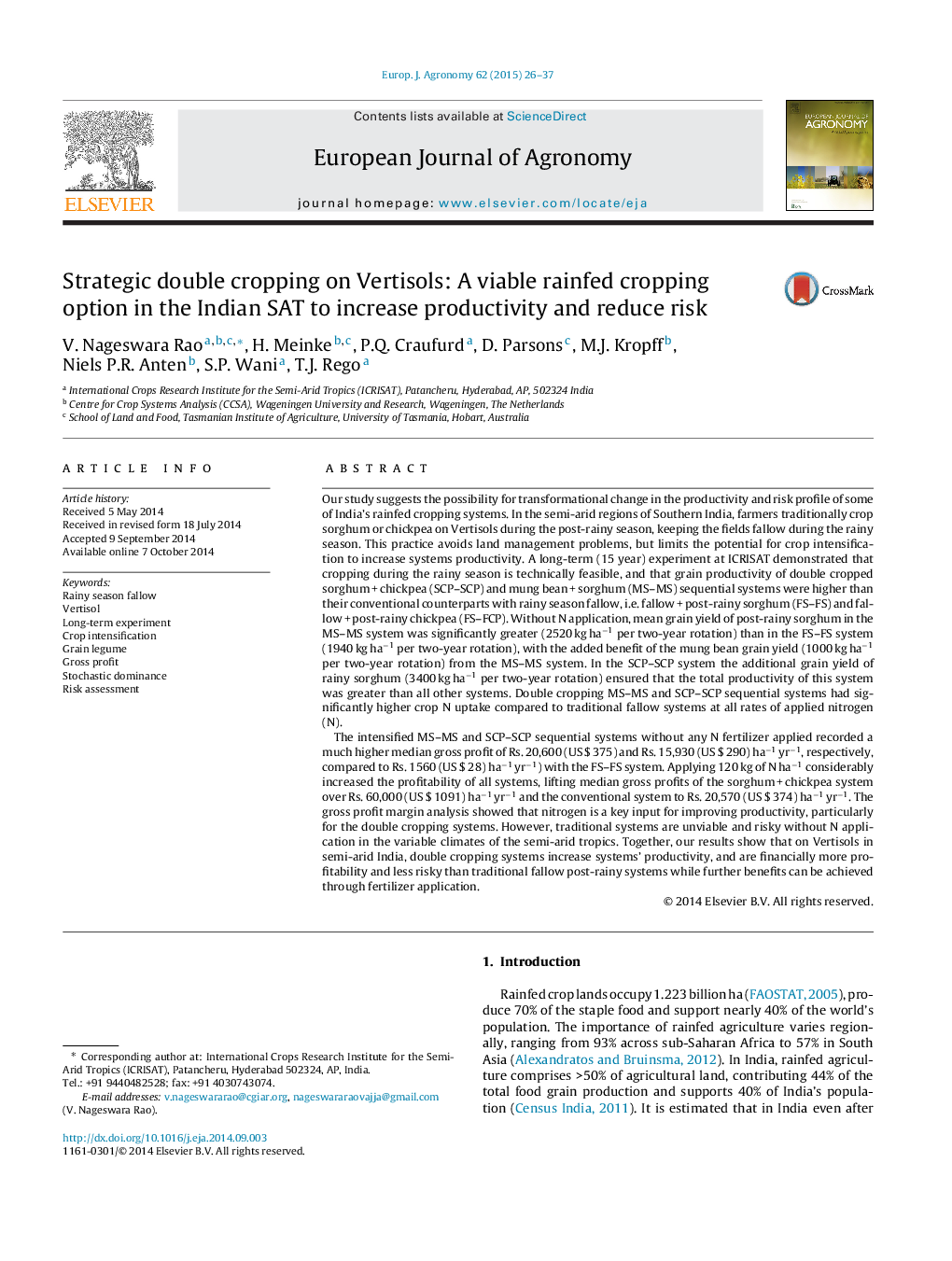| کد مقاله | کد نشریه | سال انتشار | مقاله انگلیسی | نسخه تمام متن |
|---|---|---|---|---|
| 4508842 | 1624463 | 2015 | 12 صفحه PDF | دانلود رایگان |

• Productivity of double crop systems was greater than fallow post-rainy systems, a better choice to risk-averse farmers.
• Double cropping increased systems’ N uptake due to cropping in the rainy season instead of fallowing.
• Legumes in the improved cropping systems contributed residual N to sorghum and enhance sorghum yields in these systems.
• Gross profits analysis of cropping systems indicates N is the key for improving productivity.
• Traditional fallow systems on Vertisols are economically risky without N application to the crops.
Our study suggests the possibility for transformational change in the productivity and risk profile of some of India's rainfed cropping systems. In the semi-arid regions of Southern India, farmers traditionally crop sorghum or chickpea on Vertisols during the post-rainy season, keeping the fields fallow during the rainy season. This practice avoids land management problems, but limits the potential for crop intensification to increase systems productivity. A long-term (15 year) experiment at ICRISAT demonstrated that cropping during the rainy season is technically feasible, and that grain productivity of double cropped sorghum + chickpea (SCP–SCP) and mung bean + sorghum (MS–MS) sequential systems were higher than their conventional counterparts with rainy season fallow, i.e. fallow + post-rainy sorghum (FS–FS) and fallow + post-rainy chickpea (FS–FCP). Without N application, mean grain yield of post-rainy sorghum in the MS–MS system was significantly greater (2520 kg ha−1 per two-year rotation) than in the FS–FS system (1940 kg ha−1 per two-year rotation), with the added benefit of the mung bean grain yield (1000 kg ha−1 per two-year rotation) from the MS–MS system. In the SCP–SCP system the additional grain yield of rainy sorghum (3400 kg ha−1 per two-year rotation) ensured that the total productivity of this system was greater than all other systems. Double cropping MS–MS and SCP–SCP sequential systems had significantly higher crop N uptake compared to traditional fallow systems at all rates of applied nitrogen (N).The intensified MS–MS and SCP–SCP sequential systems without any N fertilizer applied recorded a much higher median gross profit of Rs. 20,600 (US $ 375) and Rs. 15,930 (US $ 290) ha−1 yr−1, respectively, compared to Rs. 1560 (US $ 28) ha−1 yr−1) with the FS–FS system. Applying 120 kg of N ha−1 considerably increased the profitability of all systems, lifting median gross profits of the sorghum + chickpea system over Rs. 60,000 (US $ 1091) ha−1 yr−1 and the conventional system to Rs. 20,570 (US $ 374) ha−1 yr−1. The gross profit margin analysis showed that nitrogen is a key input for improving productivity, particularly for the double cropping systems. However, traditional systems are unviable and risky without N application in the variable climates of the semi-arid tropics. Together, our results show that on Vertisols in semi-arid India, double cropping systems increase systems’ productivity, and are financially more profitability and less risky than traditional fallow post-rainy systems while further benefits can be achieved through fertilizer application.
Journal: European Journal of Agronomy - Volume 62, January 2015, Pages 26–37